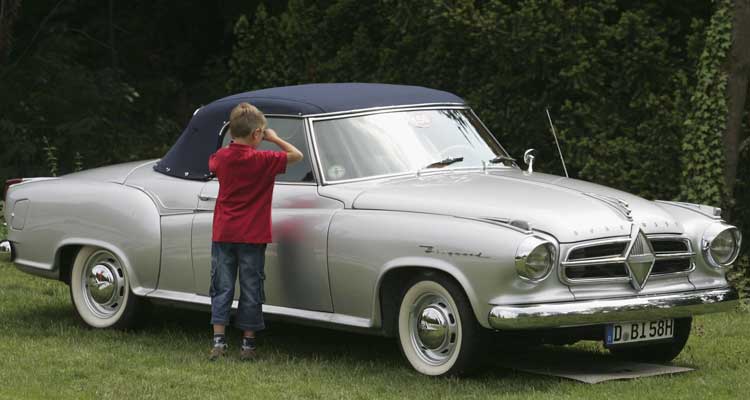Borgward Isabella Coupe
It sold in hundreds of thousands, but still couldn't save its maker, says David Wilkins

The roll-call of lost British car manufacturers is a long one. For some, such as Riley, Wolseley and Triumph, it was a lingering death. They were sucked into British Leyland, where whatever cachet their names had once enjoyed was destroyed by years of lazy-badge engineering. Others, like Jensen, simply went bust.
The roll-call of lost British car manufacturers is a long one. For some, such as Riley, Wolseley and Triumph, it was a lingering death. They were sucked into British Leyland, where whatever cachet their names had once enjoyed was destroyed by years of lazy-badge engineering. Others, like Jensen, simply went bust.
These losses are no great mystery; they are, at least, consistent with a long-run pattern of decline in UK car-making. In Germany, where the industry has been stronger, the losses have been fewer but are harder to explain. There, the companies that failed were often respected innovators. Glas fell to BMW in 1966, while in 1969, NSU succumbed to Audi, by then part of VW.
Perhaps the biggest German loss was Borgward, based in the Sebaldsbrück district of Bremen, founded by the forbidding Carl F Borgward in 1928.
Before World War Two, Borgward took over the Hansa and Lloyd marques, which along with the company's Goliath brand, survived into the Fifties as badges for the group's small, two-stroke-engined cars.
The Borgward brand itself was reserved for the company's larger models. At the top of the range in the Fifties was the Borgward Hansa 2400, a more modern-looking car than its Opel and Mercedes rivals. This was replaced in 1959 by the P100. These bigger cars were built only in very small numbers.
The car for which Borgward is probably best known, however, is the pretty Isabella, which was introduced in 1954. Several varieties of Isabella were produced over the car's seven-year life; the saloon looked neat, and spawned a good-looking estate version. There was even a pick-up.
But most attractive, by a big margin, was the Isabella coupe. At the front, it shared its traditional rhombus-shaped Borgward grille badge with its saloon counterparts. Behind the badge, however, sat a much lower, sleeker bodyshell. This had a stylishly curvy crease that ran along each side and kicked up over the rear wheels.
The only dodgy element were the tailfins that were sometimes fitted, which looked a bit tacked on. The coupe shared the more powerful engine fitted to the TS version of the saloon; otherwise, it was much the same under the skin as other Isabellas.
Given that the Isabella was so popular -- over 200,000 were built -- how could Borgward have failed? In 1960, a number of factors seem to have united to bring the company down.
Demand for the group's small two-stroke cars was falling, while the Isabella's smaller sister, the Arabella, had a troubled birth. This car was priced too low and was considered to be under-developed at the time of its launch.
The Bremen state government attempted to prop Borgward up, but production slumped to a fraction of previous levels. All rescue attempts, including one by Chrysler, failed and the company was wound up in 1961. Carl Borgward, who had relinquished control at the time of the rescue attempt by Bremen authorities, died in 1963.
So is there anything left of Borgward, apart from fond memories and a few cherished Isabellas? The answer is yes; while the name has disappeared, cars are being made again at Borgward's old Sebaldsbrück site.
When Borgward moved out, the van-maker Henschel moved in. Then in 1971, Daimler-Benz acquired Hanomag-Henschel (as it had become) and in 1977, began building Mercedes T1 Transporter vans there. Finally, the plant was trusted to build a passenger car, the T-model estate version of the W123 range.
Today's Bremen-built cars, the C-class estate, CLK, SL and SLK, are among the more stylish Mercs. Thanks to Borgward's Isabella, there is a long tradition of good-looking Sebaldsbrück cars to uphold.
Join our commenting forum
Join thought-provoking conversations, follow other Independent readers and see their replies
Comments
Bookmark popover
Removed from bookmarks